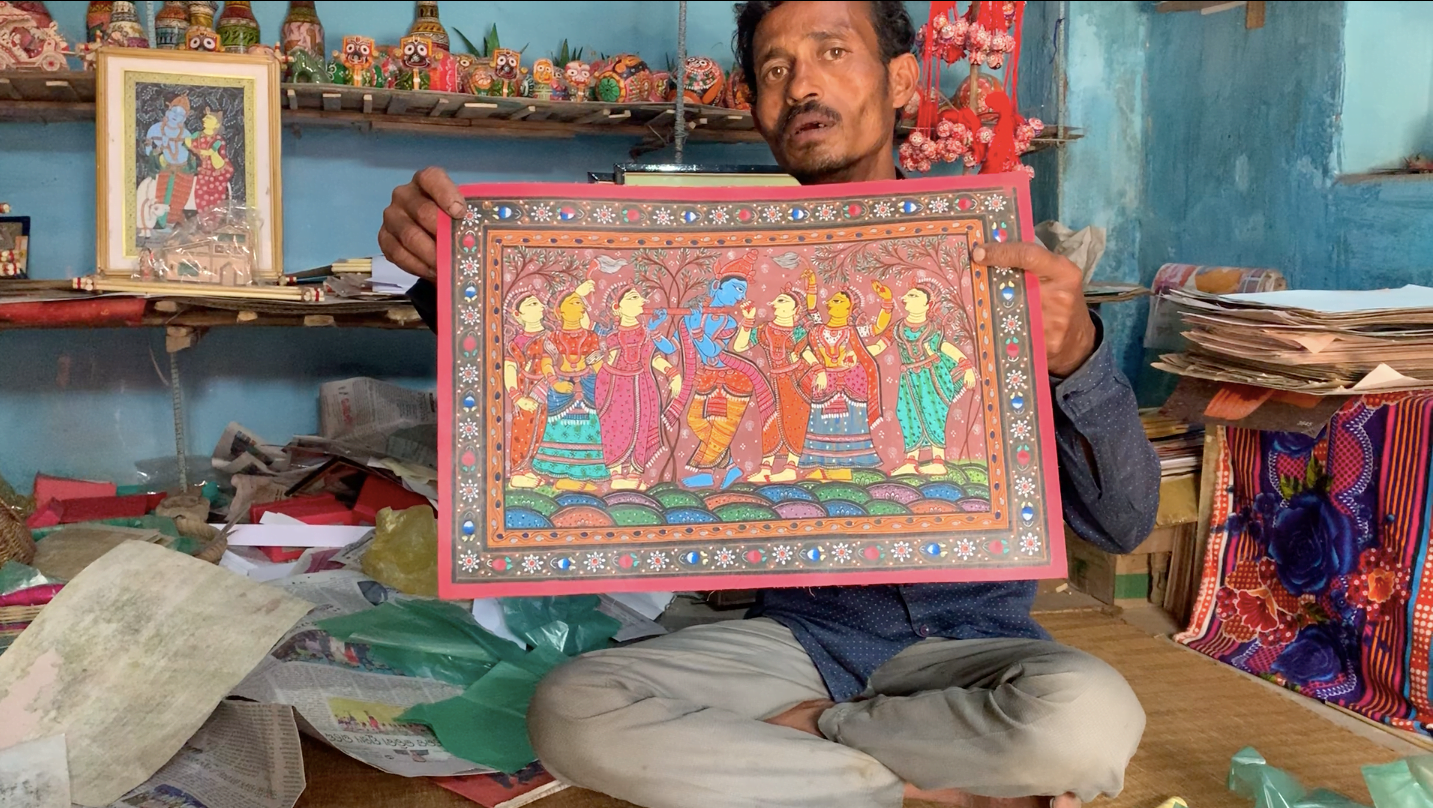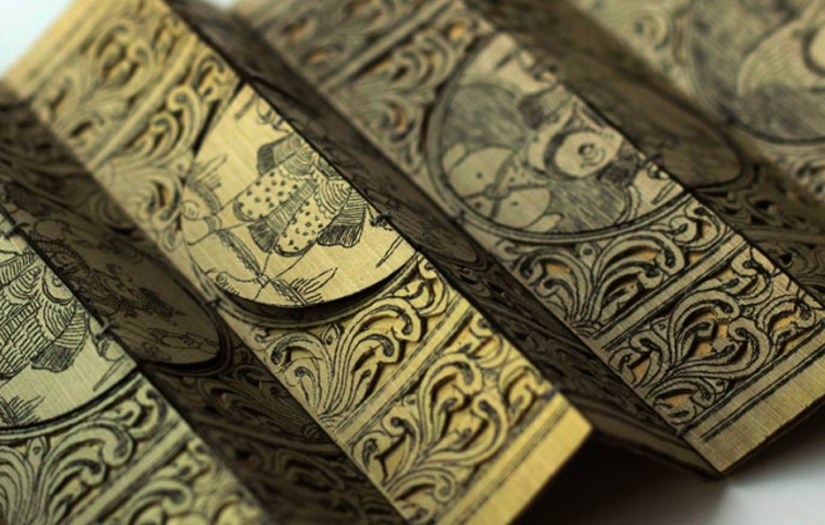Inside the land of Odisha- Incredible India’s best-kept secret is a small bustling village Raghurajpur. Located around 15 km from Puri, the village houses around 500 chitrakars (artists). These artists are the curators of the 900-year old art of Pattachitra, the art of painting on cloth.
Raghurajpur is also the birthplace of the famous Pattachitra artist – Dr. Jagganath Mahapatra who played a major role in the growth of the art.
History
The original art dates back to 5 BC. The ‘pattas’ told stories about Indian folklore and recited the glories of the Lord of Universe- Lord Jagganath and his siblings. The major role of the paintings was that it was a substitute for the idols of the deities. The religious value attached to these paintings increased their stature.
The Making of Pattachitra
The painting is done on specially stiffened seven layers of cloth which are cut into discs. The piece of cloth known as Patta or a dried palm leaf is first painted with chalk and gum. Over this prepared surface images of various Gods, Goddesses, and ancient tales are painted and decorated with flowers. Depicting ancient culture and scenes,with vibrant colors and delicate and beautiful art, these paintings are a sight worthy of appreciation.

Artists and their Legacy

Set amidst groves of palm, coconut, and jackfruit, Raghurajpur is a small village with about 120 houses lined in two rows, housing artists that are carrying forward an ancient legacy. Each house has at least one artisan practicing Pattachitra art. The houses are adorned in murals and artistic designs giving quite proof of their intricate work.
The art represents the artist’s imagination and is an attempt at ‘Recreating the Historical Anecdotes’ through paints and brushes. The original art consisted only of Pattachitra paintings. Later on, they evolved through the years, and today produce not just elegant cloth paintings but a diverse variety of products. They create papier-mache masks, paintings on coconuts and betels, stone idols, traditional masks, Tussar paintings, palm leaf engravings, and cow dung toys and sculptures.
Innovation Over The Years
Tussar Paintings
Tussar painting is a form of Pattachitra art where the paintings are done on silk sarees. The most popular variety of cloth being gauze-like cloth, tussar silk, and so on. Tussar paintings are theme-based art with a lot of motifs and bright colors, made from natural dyes. The sarees are adorned with distinguished borders and intricate designs like those in the temple deities. Odisha is the land of Lord Jaganath, so most sarees have stories based on such religious tales. Women usually wear such Tussar Silk sarees on festive occasions.

Palm Leaf Engravings- Talapatrachitra
In India, palm leaf writing is probably the most ancient form of writing. These palm leaf manuscripts are so precious that finding one is as if owning a piece of a three-thousand-year-old history. The other name for Palm leaf engravings is ‘Talapatra Chitra’. Tala means palm, Patra meaning leaf, and Chitra means illustration.

The unripe leaves of the palm tree are first cut and semi-dried to prepare the palm leaf. Then they are buried in swamps for 4-5 days for seasoning and then dried. After they dry out, the leaves are stitched together. The etching is done within lines using an iron pen on leaf strips. To highlight the figures, a paste made of bean leaves, charcoal made of burnt coconut shells, til oil, and turmeric is rubbed on the etching. Artists prefer natural and organic materials so they use vegetable and mineral colors for painting.
Each engraving has a different story to tell. What makes these simple engravings beautiful are the ornate details of dresses, hairstyles, and idols. Durga, Ganesha, and Saraswati, Radha, and Krishna are the most commonly used themes.
Papier Mache Art

Papier Mache skill is practiced by a lot of craftsmen in Raghurajpur. The art is a craft made of paper pulps. The range of products is diverse. Right from masks, lampshades to home decor items, the technique can produce everything.
The making of these products begins when paper, waste cloth, and different kinds of natural fibers are soaked and beaten into a pulp and made into a mixture by adding a variety of seeds and gums for strength and as protection from termites. They add special clays and bio-wastes for reinforcement and making of the structure. The entire process makes the medium so malleable that it can be molded into innumerable forms.
Cow Dung Toys
Cow dung has been used as a substitute for making toys for quite a few centuries. It is more organic and economical as compared to wooden toys. The raw material is free and there is no extra production cost. Women of stone carver communities make these toys. The designs are simple and are painted in bright colors to make them attractive.
Painting on Coconut Shells and Betels
Coconut shell painting is a fascinating craft and also people use it for worship. This is a unique type of art of the artists of Raghurajpur. Instead of wasting the coconut shell, they are re-utilized by making artistic crafts like hanging painted coconut. Coconut shell painting is used in shops and homes to protect from the evil eye.
Coconut shell painting involves the Gods and Goddesses of Odisha namely Lord Jagannath (a form of Krishna), Lord Balabhadra, and Maa Subhadra, in the colors black, white, and yellow respectively.

The process begins by fixing a thread inside the coconut shell by making a hole and then fixing the halved shell with a white adhesive. After this, mud color cloth is wrapped over the joined portion or middle portion of the coconut shell using synthetic adhesive to avoid breakage. Before starting to paint, they coat the shell with a paste of tamarind seed powder, white synthetic adhesive, and a small amount of water. The white-colored acrylic paste is applied as a background. Artisan starts painting directly using different types of brush without any rough sketch of the image and the ornamentation of the painting is made by using 3d cone outliner. We can also find paintings on bottles and clay pots.

Specialty
There is an annual religious festival ‘Rath Yatra’ that takes place in Puri. Raghurajpur is the only village that makes the traditional decorative cloth ‘Patas’. It is used under the throne of Lord Jagganath and on the three chariots used during the Rath Yatra.
Ganjifa playing cards or the Dashavatar playing cards of Odisha are also part of the pattachitra genre. These unique paintings, especially the playing cards, are on display in museums across the world.
Although natural dyes from plants and minerals may have been replaced by artificial and synthetic colors in many areas, traditional artists of Raghurajpur prefer to use organic colors. Thus, besides creating aesthetics, they do not leave behind any residue or dangerous fumes for the environment.
An Artistic Tribute
An Indian Artist Saptarshi Dey put together his love for films and art and created a tribute to a few international film posters in the Pattachitra style. Right from The Harry Potter to the Titanic and The Avatars, the film posters are an amalgamation of history and modern films.
The Recreation of Harry Potter’s Poster
The recreation of Titanic and The Avatars
Decline
Over the years, the art’s popularity began to decline. During the 1940s the artisans were under severe stress due to a sharp dip in their income. The conditions went so bad that at one point in time, the artists were forced to practice agriculture for their survival.
Global Initiative
In the 1940s an American Lady Ms. Helena Zealy was fascinated by the grandeur of the Pattachitra. She realized that the art was dying and artists were suffering, so she made an effort to revive the art. She held Pattachitra exhibitions in America and invited connoisseurs of art to examine these mystical and unique paintings. Soon, the artists were sending Pattachitra shipments to America and getting quite the needed income to sustain themselves. In trying to save the art form, she internationalized Pattachitra and opened new doors for the art form across the seven seas.
Government to the Rescue
In 1998, INTACH (Indian National Trust for Art and Cultural Heritage) took matters into their hands and after two years of research and documentation, they declared Raghurajpur as a ‘Heritage Village’ in 2000. They developed it as a crafts village and built an interpretation center. Artists were provided commissioned work on houses and a rest house.
E-commerce
Padmini Dian, Handlooms, Textiles and Handicrafts Minister recently launched an e-commerce website (www.utkalikaodisha.in). The Odisha State Cooperative Handicrafts Corporation Ltd (Utkalika) took this initiative to promote Odishi art. People can order now handicrafts and handloom items of Odisha through the website and the app on the Google play store.
A feature of the Startup Bharat series disclosed a techie named Rakesh Parida, founder of Thumri. Thumri is a global platform that connects the artist to the buyers directly. This helps to minimize hidden costs and provides maximum profits to the artist.
Another Reason to Buy
The main reason to buy these artworks is not just their traditional or historical importance. The artists are trying hard to conserve the art form. Buying such masterpieces will not only add a great décor to your living room but also fills their pockets. It also encourages them to keep practicing this as an occupation. Speaking of environmental benefits, the products are completely organic, so they do not pose any threats to the environment.
The raw materials and art pieces are completely ‘Made in India’ products. This way, the wealth stays in India. It is an appreciation for the artists who work on even such low wages just in the attempt of keeping the legacy alive. If you like to buy such traditional pieces, make sure to visit our Clios Heritage Store, which is our attempt at helping to preserve this valuable art.
All images belong to their respective owners.

